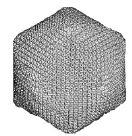Plant Pathology Department
Date of this Version
2013
Document Type
Article
Citation
Journal of General Virology 94:11 (November 2013), pp. 2549–2556; doi: 10.1099/vir.0.055251-0
Abstract
Most chloroviruses encode small K+ channels, which are functional in electrophysiological assays. The experimental finding that initial steps in viral infection exhibit the same sensitivity to channel inhibitors as the viral K+ channels has led to the hypothesis that the channels are structural proteins located in the internal membrane of the virus particles. This hypothesis was questioned recently because proteomic studies failed to detect the channel protein in virions of the prototype chlorovirus Paramecium bursaria chlorella virus 1 (PBCV-1). Here, we used a mAb raised against the functional K+ channel from chlorovirus MA-1D to search for the viral K+ channel in the virus particle. The results showed that the antibody was specific and bound to the tetrameric channel on the extracellular side. The antibody reacted in a virus-specific manner with protein extracts from chloroviruses that encoded channels similar to that from MA-1D. There was no cross-reactivity with chloroviruses that encoded more diverse channels or with a chlorovirus that lacked a K+ channel gene. Together with electron microscopic imaging, which revealed labelling of individual virus particles with the channel antibody, these results establish that the viral particles contain an active K+ channel, presumably located in the lipid membrane that surrounds the DNA in the mature virions.


Comments
Copyright © 2013 Society for General Microbiology. Used by permission.